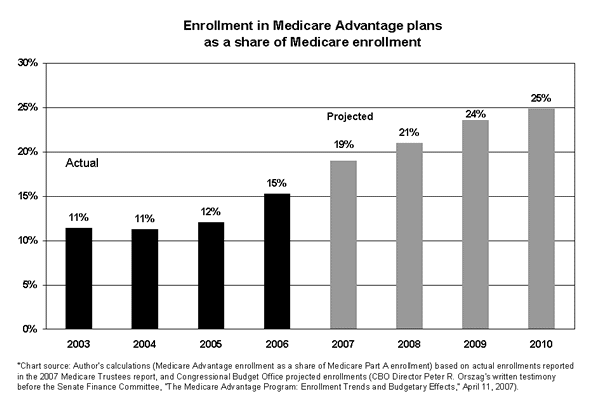See Snapshots archive.
Snapshot for June 13, 2007.
Privatizers lose Social Security battle, but make inroads in Medicare
The share of Medicare beneficiaries enrolled in privatized plans has grown rapidly since Congress passed the Medicare Modernization Act of 2003, which ratcheted up payments to private plans. At the current pace, one in four beneficiaries will be in a private plan by the end of the decade (See Chart).

These so-called Medicare Advantage plans1 were initially justified as a way to save the government money through private-sector cost savings. But Medicare pays private-sector providers 12% more than it costs the government to provide these services directly.2
More than half the projected growth in enrollment is in private fee-for-service (PFFS) plans,3 which mimic Medicare’s fee-for-service structure and provide no efficiency gains.4 To add insult to injury, these plans bilk taxpayers even more than other kinds of private plans: PFFS markups are 19% over the cost of government-provided Medicare.5
Congress is currently pondering how to expand health coverage for uninsured low-income children. Under pay-as-you-go rules, Congress has to offset the $50 billion it has budgeted to expand the State Children’s Health Insurance Program (SCHIP). The Congressional Budget Office estimates that ending overpayments to private plans would save $54 billion over four years,6 money that could be used to insure low-income children.
Notes
1. Before the Medicare Modernization Act, these were called Medicare + Choice plans. Unlike Medigap plans, Medicare Advantage plans do not simply supplement original Medicare coverage (Part A hospital coverage and Part B medical coverage). Instead, hospital and medical coverage is provided through private companies that receive Medicare funds. Some Medicare Advantage plans also provide additional benefits, including Part D prescription drug coverage.
2. Medicare Payment Advisory Commission (MedPAC), “Report to the Congress: Medicare Payment Policy,” March 2007.
3. Author’s calculations, based on CBO Director Peter R. Orszag’s written testimony before the Senate Finance Committee, April 11, 2007.
4. Written testimony of MedPAC Executive Director Mark E. Miller before the Health Subcommittee of the House Ways and Means Committee, “Private Fee-for-Service Plans in Medicare Advantage,” May 22, 2007.
5. MedPAC Report to Congress, March 2007.
6. CBO Director Peter Orszag’s written testimony before the Senate Finance Committee, April 11, 2007.
